
Perspective: Multiscale computational models for crop improvement (Plant J)
Throughout the plant science community, the use of computational or in silico analyses which precede traditional studies are gaining traction to identify research opportunities. Multiscale computational models are those which assimilate data from all biological system levels from gene to ecosystem. Benes…
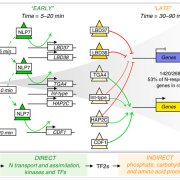
Transient genome-wide interactions of the master transcription factor NLP7 initiate a rapid nitrogen-response cascade (Nature Comms.)
Transcription factors (TFs) and their genome-wide targets form gene regulatory networks that allow organisms to respond to stimuli. However, conventional biochemical assays only identify a subset of the TF-target interactions. In this paper, Alvarez et al. elucidate the genetic network of NIN-LIKE PROTEIN…
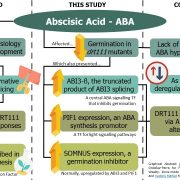
DRT111/SFPS splicing factor controls ABA sensitivity during seed development and germination (Plant Physiol)
Abscisic acid (ABA) acts on different plant physiological and developmental processes by quite complex mechanisms. In fact, some of these processes interact with light signaling and some are controlled by alternative splicing. In this paper, Punzo et al. show that DRT111 – a splicing factor previously…

A molecular link between photoreceptors and jasmonates (Nature Plants)
Plants balance their efforts on growth and defense depending on the situation. Competitive conditions signaled by the low ratios of red (R) to far-red (FR) light suppress defense responses mediated by the plant hormone jasmonate (JA), presumably for allocating more resources to promote plant growth.…
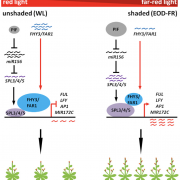
Integration of light signaling with endogenous developmental pathway to regulate flowering (Mol. Plant)
Response to changing environmental conditions is key for plant reproductive success. Previous studies have implicated FAR-RED ELONGATED HYPOCOTYL3 (FHY3) and FAR-RED IMPAIRED RESPONSE1 (FAR1) as inhibitors of flowering in phytochrome A signaling pathway. miR156-targeted SQUAMOSA PROMOTER BINDING PROTEIN…
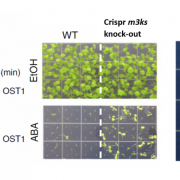
The M3Ks, a missing component discovered in the early ABA core signaling module (Nature Comms)
About a decade ago, the ABA receptors [PYR-ABACTIN RESISTANCE (PYR/PYL)/REGULATORY COMPONENT OF ABA RECEPTOR (RCAR)] were discovered, establishing the PYL-PP2C-SnRK2s core signalling module, in which ABA-binding to PYR/PYL receptors inhibits PP2C phosphatases, leading to activation of SnRK2 kinases,…
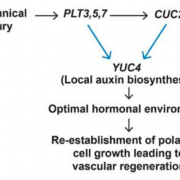
A feedforward loop controls vascular regeneration and tissue repair through local auxin biosynthesis (Development)
Plants are constantly exposed to biotic and biotic stresses that can cause tissue damage, and, as a response, plants have evolved remarkably plastic regenerative mechanisms in response to wounding. Although some genes required for regeneration have been identified in the Arabidopsis root context, most…
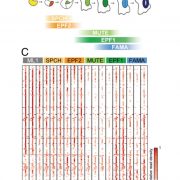
MicroRNAs and the control of stomatal development (PNAS)
Stomata mediate critical functions in plant life: gas exchange, water loss, and some environmental responses. At the molecular level, some bHLH transcription factors and a MAP-kinase pathway control a series of asymmetric and symmetric cell divisions of stomatal stem cells to form a guard cell. In…
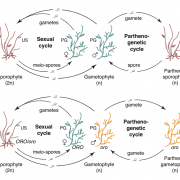
Convergent recruitment of TALE homeodomain life cycle regulators to direct sporophyte development in land plants and brown algae (eLIFE)
Life cycles in sexually reproducing plants and algae alternate between diploid (sporophytic) and haploid (gametophytic) generations. The haploid gametophyte produces gametes that mate to generate the diploid sporophyte, which in turn undergoes meiosis to generate haploid spores. Development must be coordinated…

